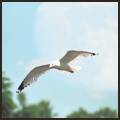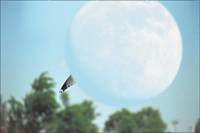Project1.PlanesBirds in Front of the Moon
Project 1. Planes/Birds in Front of the MoonIf you're even a bit romantic, chances are you like photos of the moon. Even better would be a photo of the moon with something flying in front of it, such as a plane or a bird. The problem is that it's hard to get even one of those shots, never mind two or three. Actually, it's not as hard as it might seem. The moon can be photographed if you have a lens that's long enough. I've seen some done with telescopes, and they are awesome. I don't have a telescope, but I did manage to get a shot of the moon one afternoon when the sky was still blue. I'll be using that shot for this project, and you can get it (Blue Moon.tif) from the companion website if you don't have one of your own. As for the birds or other type of airborne phenomena, it's a matter of location and trial-and-error. Thankfully, the trial-and-error part is something that's easy with a digital camerayou just keep trying until you get the shot. You can get good shots of airplanes if you live near an airport, and you can get shots of birds at just about any park. With either, you might want to shoot in the best light and set the shutter speed fairly high to prevent a blurring of the subject, be it a bird, a plane, a meteor, or some stray part of Sputnik. Hey, it could happen.
Note Don't worry if you get some of the background. You'll notice in the following sidebar that the images have backgrounds that are quite similar. We'll use a couple of tricks to help the two images blend more.
You might have to press Ctrl+Z or select Edit, Undo a couple of times, but you'll get the hang of it and make a good selection. Paste the moon in as a new layer. One of the techniques we can use to help blend the moon into the underlying image is to feather the selection before we copy the moon. Here's how to do so:
Notice how the sides of the moon are soft and blend into the sky in the underlying image. You can see that the sky was not exactly the same color, but these images were taken years apart and the photograph of the seagull was shot on (gasp!) slide film. It doesn't really matter what the source was after the image has been digitizedwhether a scanner or your digital camera does that. As for the difference in the sky, there's a trick for that, as well. Read on.... Stirring In One MaskDepending on the images you're using, you might have to do some type of corrections. You may, for example, have to resize the moon image or play with the color a little. 'We'll set the color of the moon layer in a bit, but first we have to create a mask to help blend the two layers.
It will seem as if nothing has happenedthat is, nothing seems different with the image. If you look at the Layers palette, though, you'll see a layer above the moon layer that's completely filled with white. Painting on that mask with black allows the bird layer to show through. Follow along to see what I mean.
Baking at 350° for 15 MinutesDetails, details. It's the small things that can make or break a composite image. The next couple of steps demonstrate how to blend the two images together so they appear to be one single image.
|
EAN: 2147483647
Pages: 109
- The Second Wave ERP Market: An Australian Viewpoint
- Enterprise Application Integration: New Solutions for a Solved Problem or a Challenging Research Field?
- Context Management of ERP Processes in Virtual Communities
- Distributed Data Warehouse for Geo-spatial Services
- Development of Interactive Web Sites to Enhance Police/Community Relations





